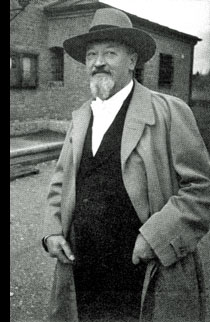|
In the year 1935, Karl Goetz made the medal, K-510, depicting his own portrait on the obverse side, and the stations of his life on the reverse. The medal was made to celebrate his 60th birthday. The stations of his life are written around a nude man carrying the symbol of the artist's birthplace, Augsburg, on his right shoulder. Born on June 28th, 1875, in Augsburg, Goetz attended the school of art in Augsburg, and continued his education in schools of art in Dresden, Leipzig, Berlin, and Düsseldorf from 1895 to 1897. He then went to Utrecht, in Holland, and later to Le Locle, during the years 1897 to 1899, spent 5 years in Paris, and in 1904 moved to Munich. He grew to love this ancient city and it became his home. One of the proudest moments of Goetz's life came when the city of Munich awarded him rights as a citizen. He lived there for forty six years, until his death on September 8, 1950.
Now an artist in his own field, Goetz led an active life, becoming a member of the Munich Artists Society, The Numismatic Society, The Antique Club of Munich, and The Austrian Association for Numismatics in Vienna.
Nevertheless, Goetz managed to create over 800 medals. A great number of these medals are shown and possessed by the Kaiser Friedrich Museum in Berlin, the Münzkabinett in Munich, the Germanische Museum Nürnberg,
|
 |
|
and the Münzkabinetts Vienna, Grafenhage, and London. The Universitetets Myntkabinett in Oslo, Norway has 69 Goetz medals on display. There are also many medals which are owned by the American Numismatic Society in New York. Some of the largest private collections in the United States are the Saginaw Valley Collection, and, of course, the KarlGoetz.com Collection.
|
Many of the medals made by Goetz were reduced in size to 60, 36, and 21 mm. The metal molds and steel dies were worked over and finished by Goetz himself, since he had gone through an engraver's apprenticeship in Augsburg. These medals were minted in bronze, silver, and gold by the Bayerisches Hauptmünzamt in Munich. One of the most common was the "Hindenburg" 80th birthday commemorative, K-386, struck in silver and gold, Mintage figures of these medals exceeded one million struck. Hundreds of metal molds and steel dies, which had been stored in the Hauptmünzamt in Munich, were rendered unserviceable by the bombings of World War II.
|